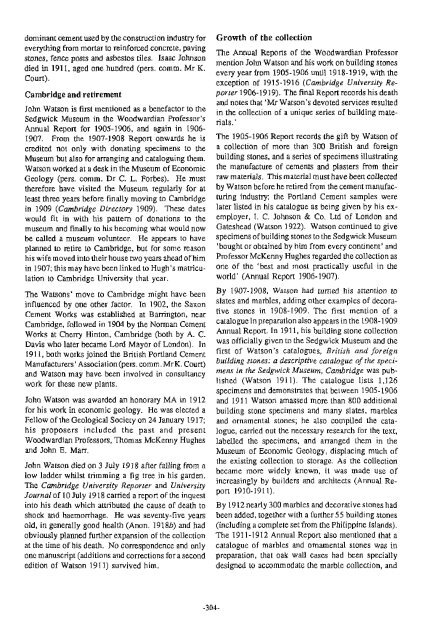Number 8 - Geological Curators Group
Number 8 - Geological Curators Group
Number 8 - Geological Curators Group
- No tags were found...
Create successful ePaper yourself
Turn your PDF publications into a flip-book with our unique Google optimized e-Paper software.
dominant cement used by the construction industry foreverything from mortar to reinforced concrete, pavingstones, fence posts and asbestos tiles. Isaac Johnsondied in 1911, aged one hundred (pers. comm. Mr K.Court).Cambridge and retirementJohn Watson is first mentioned as a benefactor to theSedgwick Museum in the Woodwardian Professor'sAnnual Report for 1905-1906, and again in 1906-1907. From the 1907-1908 Report onwards he iscredited not only with donating specimens to theMuseum but also for arranging and cataloguing them.Watson worked at a desk in the Museum of EconomicGeology (pers. comm. Dr C. L. Forbes). He musttherefore have visited the Museum regularly for atleast three years before finally moving to Cambridgein 1909 (Cambridge Directory 1909). These dateswould fit in with his pattern of donations to themuseum and finally to his becoming what would nowbe called a museum volunteer. He appears to haveplanned to retire to Cambridge, but for some reasonhis wife moved into theirhouse two years ahead of himin 1907; this may havc beenlinked to Hugh's matriculationto Cambridge University that ycar.The Watsons' move to Cambridge might have beeninfluenced by one other factor. In 1902, the SaxonCement Works was established at Banington, nearCambridge, followed in 1904 by the Norman CementWorks at Cherry Hinton, Cambridge (both by A. C.Davis who later became Lord Mayor of London). In1911, both works joined the British Portland CementManufacturers' Association(pers. comm. MrK. Court)and Watsou may have been involved in consultancywork for these new plants.John Watson was awarded an honorary MA in 1912for his work in economic geology. He was elected aFellow of the <strong>Geological</strong> Society on 24 January 1917;his proposers included the past and presentWoodwardian Profcssors, Thomas McKenny Hughesand John E. Marr.John Watson died on 3 July 1918 aftcr falling from alow ladder whilst trimming a fig tree in his garden.The Cambridge University Reporter and UniversityJournal of 10 July 1918 carried a report of the inquestinto his death which attributed the cause of death toshock and haemorrhage. He was seventy-five yearsold, in generally good health (Anon. 19186) and hadobviously planned further expansion of the collectionat the time of his death. No correspondence and onlyone manuscript (additions and corrections for a secondedition of Watson 1911) survived him.Growth of the collectionThe Annual Reports of the Woodwardian Professormention John Watson and his work on building stonesevery year from 1905-1906 until 1918-1919, with theexception of 1915-1916 (Cambridge University Reporter1906-1919). The finalReport records his deathand notes that 'Mr Watson's devoted services resultedin the collection of a unique series of building materials.'The 1905-1906 Report records the gift by Watson ofa collection of more than 300 British and foreignbuilding stones, and a series of specimens illustratingthe manufacture of cements and plasters from theirraw materials. This material must have been collectedby Watson before he retired from the cement manufacturingindustry; the Portland Cement samples werelater listed in his catalogue as being given by his exemployer,I. C. Johnson & Co. Ltd of London andGateshead (Watson 1922). Watson continued to givespecimens of building stones to the SedgwickMuseum'bought or obtained by him from every continent' andProfessor McKenny Hughes regarded the collection asone of the 'best and most practically useful in theworld' (Annual Report 1906- 1907).By 1907-1908, Watson had turned his attention toslates and marbles, adding other examplcs of decorativestones in 1908-1909. The first mention of acatalogue in preparation also appears in the 1908-1909Annual Report. In 1911, his building stone collectionwas officially given to the Sedgwick Museum and thefirst of Watson's catalogues, British and foreignbuilding stones: a descriptive catalogue of the specimensin the Sedgwick Museum, Cambridge was published(Watson 1911). The catalogue lists 1,126specimens and demonstrates that between 1905-1906and 1911 Watson amassed more than 800 additionalbuilding stone specimens and many slates, marblesand ornamental stones; he also compiled ihe catalogue,carried out the necessary research for the text,labelled the specimcns, and arranged them in theMuseum of Economic Geology, displacing much ofthe existing collection to storage. As the collectionbecame more widcly known, it was made use ofincreasingly by builders and architects (Annual Report1910-1911).By 1912 nearly 300 marbles and decorative stones hadbeen addcd, together with a further 55 building stones(including a complete set from the Philippinc Islands).The 1911-1912 Annual Report also mentioned that acatalogue of marblcs and omamental stones was inpreparation, that oak wall cases had been speciallydesigned to accommodate the marble collection, and
















